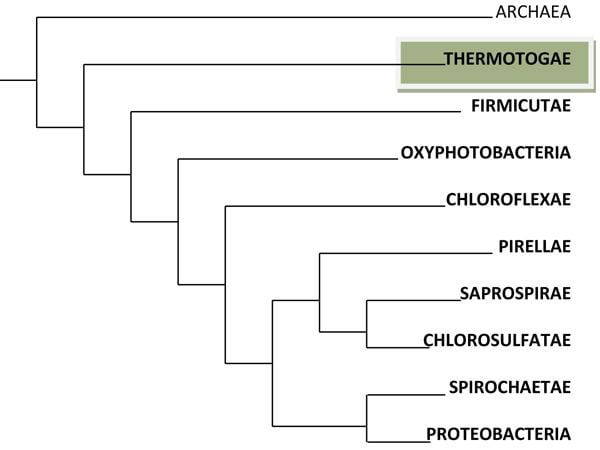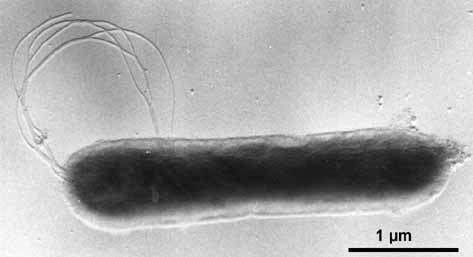 | ||
Phylum Thermotogae Reysenbach 2002 emend. Bhandari & Gupta 2014 Similar | ||
The Thermotogae are a phylum of the domain Bacteria. The phylum Thermotogae is composed of Gram-negative staining, anaerobic, and mostly thermophilic and hyperthermophilic bacteria.
Contents

Characteristics

The name of this phylum is derived from the existence of many of these organisms at high temperatures along with the characteristic sheath structure, or "toga", surrounding the cells of these species. Recently, some Thermotogae existing at moderate temperatures have also been identified. Although Thermotogae species exhibit Gram-negative staining, they are bounded by a single-unit lipid membrane, hence they are monoderm bacteria. Because of the ability of some Thermotogae species to thrive at high temperatures, they are considered attractive targets for use in industrial processes. The metabolic ability of Thermotogae to utilize different complex-carbohydrates for production of hydrogen gas led to these species being cited as a possible biotechnological source for production of energy alternative to fossil fuels.
Taxonomy

This phylum presently consists of a single class (Thermotogae), four orders (Thermotogales, Kosmotogales, Petrotogales, and Mesoaciditogales) and five families (Thermatogaceae, Fervidobacteriaceae, Kosmotogaceae, Petrotogaceae, and Mesoaciditogaceae). It contains a total of 15 genera and 52 species. In the 16S rRNA trees, the Thermotogae have been observed to branch with the Aquificae (another phylum comprising hyperthermophilic organisms) in close proximity to the Archaeal-bacterial branch point. However, a close relationship of the Thermotogae to the Aquificae, and the deep branching of the latter group of species, is not supported by phylogenetic studies based upon other gene/protein sequences. and also by conserved signature indels in several highly conserved universal proteins. The Thermotogae have also been scrutinized for their supposedly profuse Lateral gene transfer with Archaeal organisms. However, recent studies based upon more robust methodologies suggest that incidence of LGT between Thermotogae and other groups including Archaea is not as high as suggested in earlier studies.
Molecular signatures
Until recently, no biochemical or molecular markers were known that could distinguish the species from the phylum Thermotogae from all other bacteria. However, a recent comparative genomic study has identified large numbers of conserved signature indels (CSIs) in important proteins that are specific for either all Thermotogae species or a number of its subgroups. Many of these CSIs in important housekeeping proteins such as Pol1, RecA, and TrpRS, and ribosomal proteins L4, L7/L12, S8, S9, etc. are uniquely present in different sequenced Thermotogae species providing novel molecular markers for this phylum. These studies also identified CSIs specific for each order and each family. These indels are the premise for the current taxonomic organization of the Thermotogae, and are strongly supported by phylogenomic analyses. Additional CSIs have also been found that are specific for Thermotoga, Pseudothermotoga, Fervidobacterium, and Thermosipho. These CSIs are specific for all species within each respective genus, and absent in all other bacteria, thus are specific markers. A clade consisting of the deep-branching species Petrotoga mobilis, Kosmotoga olearia, and Thermotogales bacterium mesG1 was also supported by seven CSIs. Additionally, some CSIs that provided evidence of LGT among the Thermotogae and other prokaryotic groups were also reported. The newly discovered molecular markers provide novel means for identification and circumscription of species from the phylum in molecular terms and for future revisions to its taxonomy.
Phylogeny
The phylogeny based on the work of the All-Species Living Tree Project.
Taxonomy
The currently accepted taxonomy is based on the List of Prokaryotic names with Standing in Nomenclature (LSPN) and the National Center for Biotechnology Information (NCBI).
Notes:
♠ Strain found at the National Center for Biotechnology Information (NCBI) but not listed in the List of Prokaryotic names with Standing in Nomenclature (LPSN)
♥ No strains lodged at National Center for Biotechnology Information NCBI and or listed in the List of Prokaryotic names with Standing in Nomenclature (LPSN)
